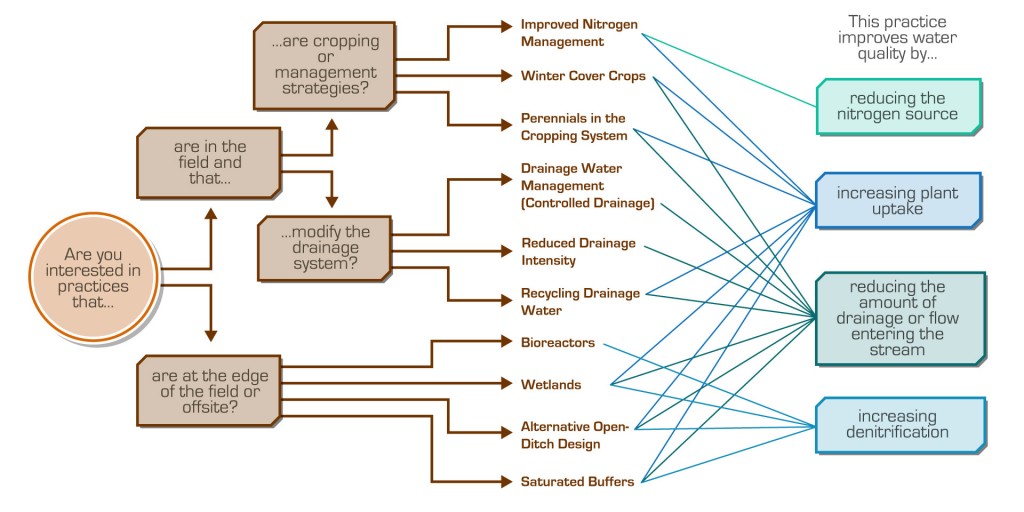Strategies to Reduce Nitrate Loss from Tile-Drained Cropland
The recently released Illinois EPA and Department of Agriculture biennial report on Illinois’ Nutrient Loss Reduction Strategy (NLRS) showed that nitrate and phosphorus loads, in addition to water flows, have increased statewide since 2013. While it may appear there has been no progress in reducing nutrient runoff, particularly from our farm fields, we know that during the 2017-2018 reporting period the agricultural sector invested more than $59 million in outreach, implementation, research, and monitoring to increase voluntary efforts. The effort is paying off, as surveys indicate that most farmers have at least some knowledge about the conservation practices listed in the strategy. The challenge ahead of us is translating this new awareness into action on the ground.

Author Jill Kostel (tan t-shirt) at Illinois Central College Constructed Wetland
Reducing nutrient loss can be difficult, particularly for farms with subsurface or “tile” drainage systems. Subsurface drainage systems were installed to convert Illinois’ original prairie-wetland landscape into some of the most productive farmland in the world. Subsurface drainage typically reduces surface runoff, but it increases soluble phosphorus and nitrate-nitrogen losses from the field. Nitrogen and phosphorous from fertilizer or natural processes such as mineralization are carried away with the drainage water. Our Illinois watersheds with the highest nitrogen losses are those with the most subsurface-drained cropland acres.
A systems approach offers an opportunity to address these tile-drainage nutrient losses. ISAP members support a systems approach to both soil health and nutrient loss reduction by coupling edge-of-field strategies with in-field cropping and management strategies. The systems approach is simply a set of strategies to manage and optimize nitrogen and phosphorous within fields, minimize runoff from the field, and reduce downstream nutrient loading. It is a combination of management, operational, and structural practices. This systems perspective can increase profitability for farms while reducing production, financial, and environmental risks, especially in times of increasing weather variability.
A terrific resource that describes the different strategies within the systems approach for reducing nitrogen loss is “10 Ways to Reduce Nitrogen Loads from Drained Cropland in the Midwest.” The publication was developed by Extension Specialists from the University of Illinois, Purdue University, Iowa State University, and University of Minnesota along with Chris Hay of the Iowa Soybean Association. Dr. Laura Christianson and her co-authors describe several types of strategies, many of which are practices included in the NLRS:
- in-field cropping and management strategies (i.e., nitrogen management, cover crops, and perennial crops);
- in-field strategies that modify the drainage system (i.e., drainage water management, reduced drainage intensity, and recycling drainage water); and
- edge-of-field strategies (i.e., denitrifying bioreactors, wetlands, alternative ditch design, and saturated buffers).

A variety of in-field and edge-of-field strategies can be used to reduce nitrate loads from tile-drained fields (Source: Christianson, L.E., J. Frankenberger, C. Hay, M.J. Helmers, and G. Sands, 2016. Ten Ways to Reduce Nitrogen Loads from Drained Cropland in the Midwest. Pub. C1400, University of Illinois Extension)
This “10 Ways” resource describes the processes affecting nitrate losses from drainage and how the practices manage those processes. For each of the 10 practices, the publication provides a description and overview of the practice, how it reduces nitrate losses, its effectiveness, where it will work, current level of acceptance, and remaining questions and opportunities for improving the practice. Economic considerations and additional benefits of the practices also are discussed.
ISAP members are focused on promoting and providing technical resources and guidance on the systems approach to address nutrient loss. This new document offers a clear and detailed listing of all the options within that approach that landowners can voluntarily adopt to do their part in addressing the nutrient loss challenge we face.
Jill Kostel, Senior Environmental Engineer for The Wetlands Initiative | jkostel@wetlands-initiative.org